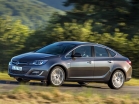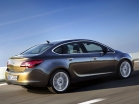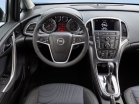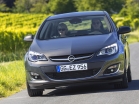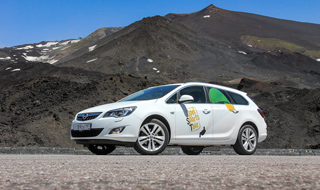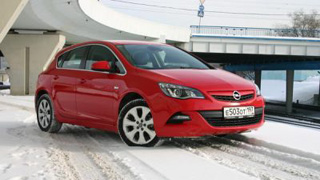Test drive Opel Astra Sport sedan since 2012 sedan
Hyundai Elantra, Peugeot 408 and Opel Astra. The battle of sedanov
Our long-term test of the Peugeot 408 sedan is coming to an end. We have already talked about the first impressions of the car, and soon we will share the sensations from the winter operation of the 408th, the developers of which are especially proud of the adaptation of the model to Russian conditions. However, the test would be inferior, we do not compare Peugeot 408 with competitors. With which? Popular Ford Focus and Skoda Octavia (which, albeit an elevator, but completely falls into the format), we felt last year, so the four -door Opel Astra and Hyundai Elantra were selected for this confrontation. Astra interested us with novelty (she debuted in Russia at the end of last year), and Elantra with a cool attitude of customers, because in 2012 only 5017 Korean sedans were sold.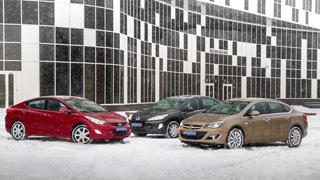 What is the reason for the modest results of the Elantra? Certainly not in design! You can treat the Asian style in different ways, but these soft, flowing lines, bright color, 17-inch wheels and tongues of the flame of the rear lights clearly attract the attention of the public. Handsomely? A matter of taste. Effective? But this cannot be taken away! But we prefer Aster. Excellent proportions, a verified profile, frying food, decorated with an integrated spoiler and a complete absence of elaborate elements. Europe! It can be seen that Opel artists worked on the appearance of the sedan no less carefully than all other representatives of the Astra family.
What is the reason for the modest results of the Elantra? Certainly not in design! You can treat the Asian style in different ways, but these soft, flowing lines, bright color, 17-inch wheels and tongues of the flame of the rear lights clearly attract the attention of the public. Handsomely? A matter of taste. Effective? But this cannot be taken away! But we prefer Aster. Excellent proportions, a verified profile, frying food, decorated with an integrated spoiler and a complete absence of elaborate elements. Europe! It can be seen that Opel artists worked on the appearance of the sedan no less carefully than all other representatives of the Astra family. 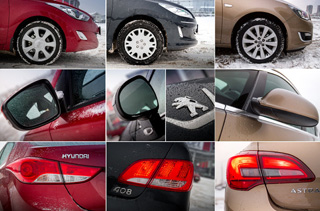 Peugeot can boast of the largest clearance of 175 mm. In Hyundai, it is 150 mm, and the lowest Opel with a result of 140 mm to the lateral mirrors of the Elantra and Astra do not complain, and the disadvantages of the viewing back will substitute parking sensors (Opel) or the camera (Hyundai). But Peugeot has small mirrors for such a length (a large dead zone is formed), and there are no assistants in parking against this background of a modest man. In front of the 408th is very similar to a dorestyling hatchback 308, on the side it also does not cause special emotions, if in the photo ... Close the stern with your hand. Again this backpack sewn behind! Designers drew inspiration in the form of Iranian 206 Sedan? Partly the situation is saved by the official dark blue color, concealing shapes. But the place of summer 17-inch alloy wheels during the re-shoes on winter tires was occupied by an ordinary 16-inch stamping with caps. So, unlike Astra and Elantra, it is unlikely that anyone will buy Peugeot 408 for his external data.
Peugeot can boast of the largest clearance of 175 mm. In Hyundai, it is 150 mm, and the lowest Opel with a result of 140 mm to the lateral mirrors of the Elantra and Astra do not complain, and the disadvantages of the viewing back will substitute parking sensors (Opel) or the camera (Hyundai). But Peugeot has small mirrors for such a length (a large dead zone is formed), and there are no assistants in parking against this background of a modest man. In front of the 408th is very similar to a dorestyling hatchback 308, on the side it also does not cause special emotions, if in the photo ... Close the stern with your hand. Again this backpack sewn behind! Designers drew inspiration in the form of Iranian 206 Sedan? Partly the situation is saved by the official dark blue color, concealing shapes. But the place of summer 17-inch alloy wheels during the re-shoes on winter tires was occupied by an ordinary 16-inch stamping with caps. So, unlike Astra and Elantra, it is unlikely that anyone will buy Peugeot 408 for his external data. 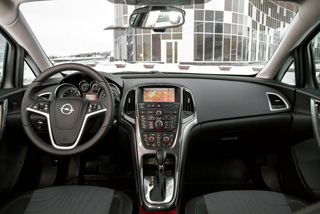 Astra wins and in the interior we got the richest Cosmo set. The pretty wavy upholstery of the seats pleases the eye, a large color screen (there is also navigation) crings the central console with a scattering buttons. However, we saw all this before and in other asters, so such an abundance of keys no longer forces to delve into the instructions. It is good and landing behind the wheel of the river adjustments (in two planes) and the front seats are sufficient for drivers of various complexions. And in winter, it is especially pleasant to have a steering wheel in a heating machine can easily do without gloves.
Astra wins and in the interior we got the richest Cosmo set. The pretty wavy upholstery of the seats pleases the eye, a large color screen (there is also navigation) crings the central console with a scattering buttons. However, we saw all this before and in other asters, so such an abundance of keys no longer forces to delve into the instructions. It is good and landing behind the wheel of the river adjustments (in two planes) and the front seats are sufficient for drivers of various complexions. And in winter, it is especially pleasant to have a steering wheel in a heating machine can easily do without gloves. 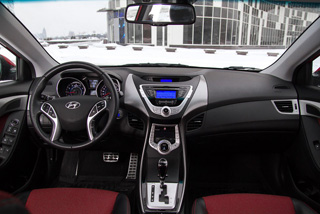 Elantra also has a departure adjustment and heating the steering wheel was given to us in the top execution of Sport. But the rest seemed to be in the inexpensive Hyundai Solaris! The seats (by the way, the most convenient in the test) and doors, the front panel are made of hard plastic, and the simple display of the audio system with bright blue lighting and completely migrated from Solaris without any changes, live. And how do you like the only (driver's) automatic window lifting? And this is in the car for 924 thousand rubles!
Elantra also has a departure adjustment and heating the steering wheel was given to us in the top execution of Sport. But the rest seemed to be in the inexpensive Hyundai Solaris! The seats (by the way, the most convenient in the test) and doors, the front panel are made of hard plastic, and the simple display of the audio system with bright blue lighting and completely migrated from Solaris without any changes, live. And how do you like the only (driver's) automatic window lifting? And this is in the car for 924 thousand rubles! 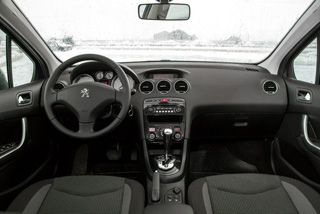 PEUGEOT is much cheaper than the ALLure execution with a turbocharged 150-horsepower engine with a volume of 1.6 liters starts from 789 thousand rubles, and our car costs 831 thousand, although the main increase (32 thousand) on the account of optional 17-inch wheels that remained on summer tires. The remaining ten thousand is the color of metallic. Therefore, do not be surprised that inside the Peugeot 408 is a simpleton. The front panel migrated here from the hatchback 308, along with a monochrome display and radio from the 90s. But the quality of materials is no worse than in Astra. And, of course, the steering wheel here is also regulated in two planes.
PEUGEOT is much cheaper than the ALLure execution with a turbocharged 150-horsepower engine with a volume of 1.6 liters starts from 789 thousand rubles, and our car costs 831 thousand, although the main increase (32 thousand) on the account of optional 17-inch wheels that remained on summer tires. The remaining ten thousand is the color of metallic. Therefore, do not be surprised that inside the Peugeot 408 is a simpleton. The front panel migrated here from the hatchback 308, along with a monochrome display and radio from the 90s. But the quality of materials is no worse than in Astra. And, of course, the steering wheel here is also regulated in two planes. 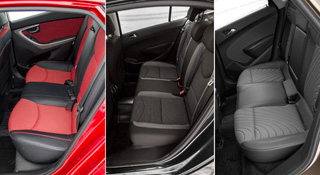 Space champion PEUGEOT 408 (in the center). No wonder! The Peugeot 408 (2710 mm) wheelbase exceeds Hyundai Elantra (2700 mm) and Opel Astra (2685 mm). But the French sedan comes from Kaluga does not have enough rear folding armrest. Therefore, it is most convenient to sit in an Elanter (left), in addition, in the top complexation there is also a sofa heating. It will be convenient for tall people only in Peugeot in the rest of the cars the head will support the roof. And the most closely in the Aster and passengers unanimously choose the Korean sedan. And even if the legs for the legs are 23 mm less here (with the same driver) than in an immense Frenchman, but it is more convenient to sit here. Plus, there is a folding armrest and heating the rear seats (!) Both of the other Peugeot. Astra boast and there is nothing at all from the back of the front chair to the rear sofa pillow 65 mm less than that of the Elantra, the central tunnel is high, and the seat itself is clearly obvious for two.
Space champion PEUGEOT 408 (in the center). No wonder! The Peugeot 408 (2710 mm) wheelbase exceeds Hyundai Elantra (2700 mm) and Opel Astra (2685 mm). But the French sedan comes from Kaluga does not have enough rear folding armrest. Therefore, it is most convenient to sit in an Elanter (left), in addition, in the top complexation there is also a sofa heating. It will be convenient for tall people only in Peugeot in the rest of the cars the head will support the roof. And the most closely in the Aster and passengers unanimously choose the Korean sedan. And even if the legs for the legs are 23 mm less here (with the same driver) than in an immense Frenchman, but it is more convenient to sit here. Plus, there is a folding armrest and heating the rear seats (!) Both of the other Peugeot. Astra boast and there is nothing at all from the back of the front chair to the rear sofa pillow 65 mm less than that of the Elantra, the central tunnel is high, and the seat itself is clearly obvious for two. 

 The most beautiful and informative devices in Hyundai (left). Astra shield (in the center) spoils radial digitization, and Peugeot scales generally become unreadable at dusk, and the speedometer is unusual. When activating the sports regime, Astra's backlight changes from blue to red. However, this can be disabled in the Flexride menu. The average fuel consumption during the test ranged from 10 to 12 l/100 km where will the driver like it more? Here the choice is no longer so unambiguous. The three sedanov is very close in dynamic characteristics. The Opel is equipped with a 140-horsepower turbo engine of 1.4 liters, Peugeot, as we have already mentioned, has 10 forces and 200 cubes more, and under the hood of Hyundai, an atmospheric engine with a volume of 1.8 liters and a capacity of 150 horses is working. All cars with six -speed automatic machines, and the scatter in acceleration to hundreds is only 0.7 seconds, and the maximum speed varies only by 5 km/h.
The most beautiful and informative devices in Hyundai (left). Astra shield (in the center) spoils radial digitization, and Peugeot scales generally become unreadable at dusk, and the speedometer is unusual. When activating the sports regime, Astra's backlight changes from blue to red. However, this can be disabled in the Flexride menu. The average fuel consumption during the test ranged from 10 to 12 l/100 km where will the driver like it more? Here the choice is no longer so unambiguous. The three sedanov is very close in dynamic characteristics. The Opel is equipped with a 140-horsepower turbo engine of 1.4 liters, Peugeot, as we have already mentioned, has 10 forces and 200 cubes more, and under the hood of Hyundai, an atmospheric engine with a volume of 1.8 liters and a capacity of 150 horses is working. All cars with six -speed automatic machines, and the scatter in acceleration to hundreds is only 0.7 seconds, and the maximum speed varies only by 5 km/h. 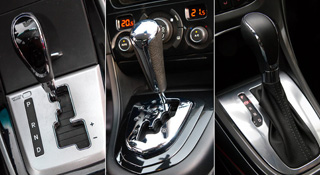 All three six -speed machines have a manual mode of operation and differ in the nuances. The Hyundai box (left) works harshly at the start, so the winter algorithm would not interfere with it. The PEUGEOT machine has both winter and sports modes, but even in ordinary drive, sometimes surprises with its hyperadapticity when acceleration to the floor will hold the current gear even when the driver has already released the gas pedal. It is as if waiting for the dispersal about to continue. Opelevskaya automatic transmission was not seen in anything like that, and the program of its operation can be changed by the Sport or Comfort buttons on the central console, the Hyundai box starts to quickly jerk a quick jerk from the place! Opel and Peugeot begin to move with a lazy one, but then they overtake the Korean. And when accelerating from average speeds, the elapse does not have a small torque (178 N ∙ m at 4500 rpm), you have to constantly twist the engine in ringing during active maneuvers. The turbocharged engines of Opel and Peugeot have an advantage of 200 and 240 N ∙ m, respectively, and even smeared in a wide range of crankshaft revolutions, so overtaking on suburban roads is easier for them.
All three six -speed machines have a manual mode of operation and differ in the nuances. The Hyundai box (left) works harshly at the start, so the winter algorithm would not interfere with it. The PEUGEOT machine has both winter and sports modes, but even in ordinary drive, sometimes surprises with its hyperadapticity when acceleration to the floor will hold the current gear even when the driver has already released the gas pedal. It is as if waiting for the dispersal about to continue. Opelevskaya automatic transmission was not seen in anything like that, and the program of its operation can be changed by the Sport or Comfort buttons on the central console, the Hyundai box starts to quickly jerk a quick jerk from the place! Opel and Peugeot begin to move with a lazy one, but then they overtake the Korean. And when accelerating from average speeds, the elapse does not have a small torque (178 N ∙ m at 4500 rpm), you have to constantly twist the engine in ringing during active maneuvers. The turbocharged engines of Opel and Peugeot have an advantage of 200 and 240 N ∙ m, respectively, and even smeared in a wide range of crankshaft revolutions, so overtaking on suburban roads is easier for them. 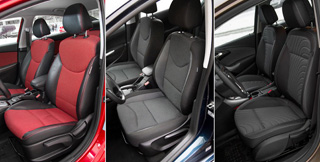 The front seats liked the most at Enntra, they pleasantly hug the body, and the fabric has good frictional properties, so you can’t slip out in corners. And the most unsuccessful chairs of Peugeot. And there are few lateral support, and the profile is not the best (there is no lumbar backup at all). In addition, the passenger chair in the 408th is installed too high, and there is no adjustment, which allows to lower it lower. In all three machines, the angle of inclination of the back is stamped, although subjectively, Elantra is perceived by the most dynamic car, the nimble automatic quickly accepts the commands of the floor (!) Pedal of gas, and the loud voice of the engine during dynamic driving, surprisingly, does not cause disgust. Clothing machine. But as soon as the next snowfall was falling on Moscow, it diminished enthusiasm. The reason lies in the stabilization system. The usual start from the place on the snow -covered road, VSM begins to blur a light bulb on the dashboard (they say, Gasha is slipping), the box goes to the second step and here ... Hyundai pecks with his nose so that passengers involuntarily nod their heads. The third is the same!
The front seats liked the most at Enntra, they pleasantly hug the body, and the fabric has good frictional properties, so you can’t slip out in corners. And the most unsuccessful chairs of Peugeot. And there are few lateral support, and the profile is not the best (there is no lumbar backup at all). In addition, the passenger chair in the 408th is installed too high, and there is no adjustment, which allows to lower it lower. In all three machines, the angle of inclination of the back is stamped, although subjectively, Elantra is perceived by the most dynamic car, the nimble automatic quickly accepts the commands of the floor (!) Pedal of gas, and the loud voice of the engine during dynamic driving, surprisingly, does not cause disgust. Clothing machine. But as soon as the next snowfall was falling on Moscow, it diminished enthusiasm. The reason lies in the stabilization system. The usual start from the place on the snow -covered road, VSM begins to blur a light bulb on the dashboard (they say, Gasha is slipping), the box goes to the second step and here ... Hyundai pecks with his nose so that passengers involuntarily nod their heads. The third is the same! 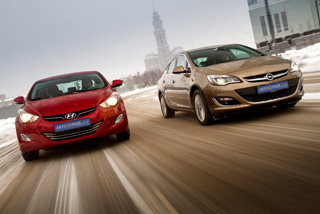 It is not clear what the Koreans were worn out with VSM algorithms, but a similar situation arises whenever these three factors are combined: a quick start on a slippery road, working track control and gear switching. The reasonable objection must be moved more smoothly. And if you need to sharply accelerate into the floor, when the car is already in motion? The machine is thrown away by a couple of steps, Elantra accelerates and ... again the very jerk! This can only be avoided by a small discharge of gas at the time of transmission. Or turning off VSM.
It is not clear what the Koreans were worn out with VSM algorithms, but a similar situation arises whenever these three factors are combined: a quick start on a slippery road, working track control and gear switching. The reasonable objection must be moved more smoothly. And if you need to sharply accelerate into the floor, when the car is already in motion? The machine is thrown away by a couple of steps, Elantra accelerates and ... again the very jerk! This can only be avoided by a small discharge of gas at the time of transmission. Or turning off VSM. 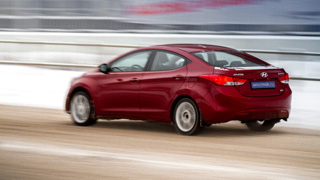 By the way, in snowfalls this very VSM I just want to get out of the car. Settings are horror! You turn off the cleared prospectus to an uncleaned street, and that’s all, Elantra almost stops, with difficulty accelerating under the blinking eye of the system. Either the point of medium tires (Brigdestone Ice Cruiser 7000), or the engineers really were not very bothering with the programming of the VSM work in such conditions, the machine was created for the American market. The above could be called nit -picking, but the electronic assistants Opel and Peugeot work much more efficiently and more delicate!
By the way, in snowfalls this very VSM I just want to get out of the car. Settings are horror! You turn off the cleared prospectus to an uncleaned street, and that’s all, Elantra almost stops, with difficulty accelerating under the blinking eye of the system. Either the point of medium tires (Brigdestone Ice Cruiser 7000), or the engineers really were not very bothering with the programming of the VSM work in such conditions, the machine was created for the American market. The above could be called nit -picking, but the electronic assistants Opel and Peugeot work much more efficiently and more delicate! 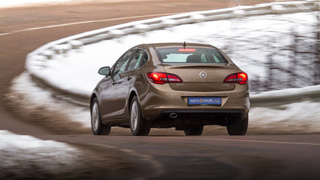 The Opel Astra sedan is led so far, despite its attractive image. 1533 cars were sold for the rest of the last year, and in January-February 2013 there are only 1235. But, one way or another, Astra is still sold better than Hyundai Elantra on the Astra, such a winter and at all for the pleasure of Nokian hakkapeliitta 7 in combination with Adequate ESP settings make it understandable and obedient to control. You can not even think about starting from a traffic light at the anti -wings system smoothly and unobtrusively eliminate excess traction. And no jerks when switching the gears! Without unpleasant surprises, it also does in corners. And, most importantly, the steering wheel of the Astra sedan turned out to be more informative than we noted in the winter test of the hatchback three years ago! Moreover, on exactly the same tires and in the standard operating mode of the Flexride chassis (you can choose Sport, then the force grows a little). Apparently, in Opel they listened to criticism and reconfigured the steering amplifier during the restyling of the model.
The Opel Astra sedan is led so far, despite its attractive image. 1533 cars were sold for the rest of the last year, and in January-February 2013 there are only 1235. But, one way or another, Astra is still sold better than Hyundai Elantra on the Astra, such a winter and at all for the pleasure of Nokian hakkapeliitta 7 in combination with Adequate ESP settings make it understandable and obedient to control. You can not even think about starting from a traffic light at the anti -wings system smoothly and unobtrusively eliminate excess traction. And no jerks when switching the gears! Without unpleasant surprises, it also does in corners. And, most importantly, the steering wheel of the Astra sedan turned out to be more informative than we noted in the winter test of the hatchback three years ago! Moreover, on exactly the same tires and in the standard operating mode of the Flexride chassis (you can choose Sport, then the force grows a little). Apparently, in Opel they listened to criticism and reconfigured the steering amplifier during the restyling of the model. 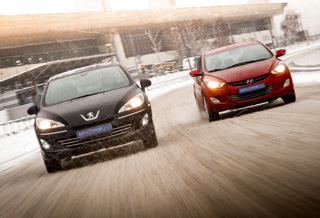 But to the transparency of the Peugeot steering wheel and Astra thanks the old, like hydraulics! This is especially valuable just on slippery coatings, when the steering wheel, saturated with feedback, adds a little confidence to the driver, allowing you to better feel the way. The main thing is not to forget that Peugeot is shod in unsolved tires. The stabilization system is turned off here, but only up to 50 km/h, for example, if you need to get out of a snowdrift. And this can be relevant for the 408th with his clearance of 175 mm you begin to feel permissiveness and climb where only all-wheel drive cars break.
But to the transparency of the Peugeot steering wheel and Astra thanks the old, like hydraulics! This is especially valuable just on slippery coatings, when the steering wheel, saturated with feedback, adds a little confidence to the driver, allowing you to better feel the way. The main thing is not to forget that Peugeot is shod in unsolved tires. The stabilization system is turned off here, but only up to 50 km/h, for example, if you need to get out of a snowdrift. And this can be relevant for the 408th with his clearance of 175 mm you begin to feel permissiveness and climb where only all-wheel drive cars break. 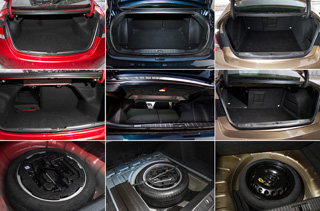 As for the luggage compartment, here is the sole leader of the Peugeot 408. The opening is the widest and most rectangular, and the volume is 560 liters! The trunk of an Elantra is smaller than 485 liters, but the lid is devoid of the inner handle. But Peugeot and Hyundai has full -sized spots on cast discs! And the most modest hold of Astra has 460 liters, and in the underground there is only a dock. In all three cars there are pockets and straps for small Hyundai objects, adjusted to the VSM nubes, also not a miss on the cleared winding paths to the actions of the steering wheel reacts without delay, and its agility in the turns even surprises! Is it all a small mass? Hyundai Elantra, according to the declared characteristics, weighs only 1277 kg per 142 kg easier than Peugeot 408! And, it seems that many saved kilograms fall into sound insulation. Against the invigorating ringing of the engine, we have nothing wrong, but the rumble of tires and other noises from the road cross all borders. However, the main negative feature of Elantra is a pendant that informs about the quality of asphalt, not missing the slightest details. Elantra hardly practices pits with sharp edges, large patches and cracks, but at the same time ... sways on the waves, sometimes making 2-3 body fluctuations!
As for the luggage compartment, here is the sole leader of the Peugeot 408. The opening is the widest and most rectangular, and the volume is 560 liters! The trunk of an Elantra is smaller than 485 liters, but the lid is devoid of the inner handle. But Peugeot and Hyundai has full -sized spots on cast discs! And the most modest hold of Astra has 460 liters, and in the underground there is only a dock. In all three cars there are pockets and straps for small Hyundai objects, adjusted to the VSM nubes, also not a miss on the cleared winding paths to the actions of the steering wheel reacts without delay, and its agility in the turns even surprises! Is it all a small mass? Hyundai Elantra, according to the declared characteristics, weighs only 1277 kg per 142 kg easier than Peugeot 408! And, it seems that many saved kilograms fall into sound insulation. Against the invigorating ringing of the engine, we have nothing wrong, but the rumble of tires and other noises from the road cross all borders. However, the main negative feature of Elantra is a pendant that informs about the quality of asphalt, not missing the slightest details. Elantra hardly practices pits with sharp edges, large patches and cracks, but at the same time ... sways on the waves, sometimes making 2-3 body fluctuations! 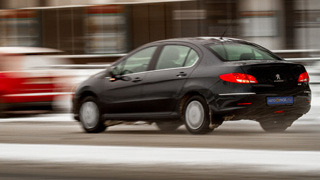 PEUGEOT 408 was well accepted by the market last year from late August 5482 sedan was sold, and in the first two months of this year, dealers sold 2273 cars. Now the 408th is 43% of the sales of all Peugeot! But the success of the focus is very far from Ford much wider than the gamma of engines and sets in Peugeot is also a noisy motor, and the main source of interference is our rough asphalt, but in general, inside 408, it is noticeably quieter. A suspension of the antipode of the Elantra. PEUGEOT is like an iron that smoothes the road, he can do everything! Moreover, with speed growth, the situation becomes even better, he ceases to notice minor irregularities. Of course, PEUGEOT also saves a large pothole, but you can boldly go on a long journey on it. And passengers do not rinse, and will not have to constantly maneuver between asphalt defects. In addition, Peugeot is able to give a lot of pleasure to active drivers despite winter tires and a large clearance, in corners it holds as glued! But there is a spoonful of tar and in the chassis of the 408th, it reacts anxiously to the longitudinal track, forcing to steer, and the rear suspension reacts hard to the joints and deformation seams of overpasses. And the blows from the pits are transmitted to the steering wheel so, the opposite side of the information content of the hydraulic power steering.
PEUGEOT 408 was well accepted by the market last year from late August 5482 sedan was sold, and in the first two months of this year, dealers sold 2273 cars. Now the 408th is 43% of the sales of all Peugeot! But the success of the focus is very far from Ford much wider than the gamma of engines and sets in Peugeot is also a noisy motor, and the main source of interference is our rough asphalt, but in general, inside 408, it is noticeably quieter. A suspension of the antipode of the Elantra. PEUGEOT is like an iron that smoothes the road, he can do everything! Moreover, with speed growth, the situation becomes even better, he ceases to notice minor irregularities. Of course, PEUGEOT also saves a large pothole, but you can boldly go on a long journey on it. And passengers do not rinse, and will not have to constantly maneuver between asphalt defects. In addition, Peugeot is able to give a lot of pleasure to active drivers despite winter tires and a large clearance, in corners it holds as glued! But there is a spoonful of tar and in the chassis of the 408th, it reacts anxiously to the longitudinal track, forcing to steer, and the rear suspension reacts hard to the joints and deformation seams of overpasses. And the blows from the pits are transmitted to the steering wheel so, the opposite side of the information content of the hydraulic power steering. 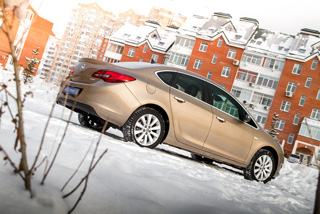 The Opel Astra sedan is offered in Russia with three engines 115-horsepower atmospheric 1.6 and turbocharged units 1.4 (140 forces) and 1.6 (180 forces). The last two are offered exclusively with six -speed automatic transmission. The most affordable option Astra Essentia 1.6 for 684 900 rubles. The equipment includes 4 airbags, but you will have to pay 15 thousand rubles for the air conditioning. Surcharge for an automaton 40 thousand rubles. At the top of the gamma, a 180-horsepower sedan performed by Cosmo for 903 900 rubles without taking into account additional options. The guarantee of 3 years or 100,000 km of the most balanced we recognize Astra. Here all the noises are at the lowest level in this three, but there is no dominant source. Opel is good and the cracks and joints do not knock out the driver and passengers from mental equilibrium on the broken coating, there is no buildup on the waves. Moreover, from the choice of the operating mode of the adaptive chassis Flexride, the picture does not change much except perhaps in Sport the suspension begins to repeat in more detail the profile of the road. And also, unlike Peugeot, tremors from irregularities and ruts are not transmitted to the steering wheel of asters, but to attack the turns is more pleasant in the Frenchman, the sensations are less synthetic, Peugeot is perceived more alive.
The Opel Astra sedan is offered in Russia with three engines 115-horsepower atmospheric 1.6 and turbocharged units 1.4 (140 forces) and 1.6 (180 forces). The last two are offered exclusively with six -speed automatic transmission. The most affordable option Astra Essentia 1.6 for 684 900 rubles. The equipment includes 4 airbags, but you will have to pay 15 thousand rubles for the air conditioning. Surcharge for an automaton 40 thousand rubles. At the top of the gamma, a 180-horsepower sedan performed by Cosmo for 903 900 rubles without taking into account additional options. The guarantee of 3 years or 100,000 km of the most balanced we recognize Astra. Here all the noises are at the lowest level in this three, but there is no dominant source. Opel is good and the cracks and joints do not knock out the driver and passengers from mental equilibrium on the broken coating, there is no buildup on the waves. Moreover, from the choice of the operating mode of the adaptive chassis Flexride, the picture does not change much except perhaps in Sport the suspension begins to repeat in more detail the profile of the road. And also, unlike Peugeot, tremors from irregularities and ruts are not transmitted to the steering wheel of asters, but to attack the turns is more pleasant in the Frenchman, the sensations are less synthetic, Peugeot is perceived more alive. 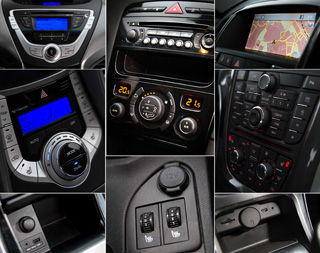 The Opel Astra sedan is better equipped. True, a couple of times navigation simply ... turned off! I had to restart the system. In all three cars, multi-level heating of the seats and a USB input, separate climate control, but in the Elanger it works worst of all first in the salon, still cold air, and then in automatic mode begin ... to sweat the glass! But where Opel unconditionally puts the opponents on the shoulder blades, is the equipment here and bixenon swivel headlights, and navigation, light and rain sensors, a salon mirror with auto -trampling. It is logical that Astra turned out to be the most expensive in our test 972,400 rubles! And for Astra, the system control system in the strip and warning about the hindrance in the dead zone are available. The most technological car from our three! So Opel Astra is quite suitable for lovers of all kinds of gadgets and those who do not think a modern machine without such a set of equipment. And, of course, we must not forget about the design, perhaps for many, it will be more important than the spaciousness in the back seat.
The Opel Astra sedan is better equipped. True, a couple of times navigation simply ... turned off! I had to restart the system. In all three cars, multi-level heating of the seats and a USB input, separate climate control, but in the Elanger it works worst of all first in the salon, still cold air, and then in automatic mode begin ... to sweat the glass! But where Opel unconditionally puts the opponents on the shoulder blades, is the equipment here and bixenon swivel headlights, and navigation, light and rain sensors, a salon mirror with auto -trampling. It is logical that Astra turned out to be the most expensive in our test 972,400 rubles! And for Astra, the system control system in the strip and warning about the hindrance in the dead zone are available. The most technological car from our three! So Opel Astra is quite suitable for lovers of all kinds of gadgets and those who do not think a modern machine without such a set of equipment. And, of course, we must not forget about the design, perhaps for many, it will be more important than the spaciousness in the back seat. 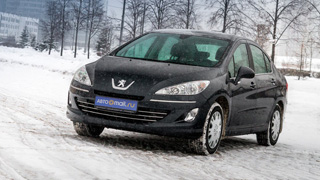 Peugeot 408 The most affordable in this test. The starting price, taking into account the current discounts of 529 thousand rubles for a sedan with a 110-horsepower atmospheric 1.6 in a simple accus configuration (2 pillows, ABS, electrical package, an additional payment for air conditioning 28 thousand rubles). The minimum price for a car with a machine gun, air conditioning and heated seats 646 thousand rubles, and the engine will already be different, with a capacity of 120 forces. True, the automatic transmission is four -band. PEUGEOT 408 with a turbocharged 150-horsepower engine and a six-speed automatic is estimated at least 721 thousand rubles. By the way, there is diesel! Peugeot 408 1.6 HDI (112 hp/254 H ∙ m) is available only with mechanics and even in the basic configuration (but already with air conditioning!) It costs 637 thousand rubles. The guarantee of 3 years or 100,000 km, with equal equipment, the cost of Astra only slightly surpasses the price tag Peugeot 408 858 900 rubles against 831 thousand (though PEUGEOT is now offered with a discount of 25 thousand rubles). It is a pity that for the Frenchman almost all of the above optional equipment of Opel is simply not available, which can scare away some customers. There are no light and rain sensors, cruise control and even the rear armrest. For an additional payment of 37 thousand rubles, only a package is offered, including a navigation system and rear parking sensors. But on the side of Peugeot a huge salon, a giant trunk with a full -sized stock and an omnivorous pendant with a decent clearance. And these are significant advantages for people who are often forced to travel long distances, travel with the whole family or just living away from large megacities. The main thing is to find a gas station with a decent 95th. The Peugeot turbo engine, of course, is capable of consuming AI-92 fuel, but it is recommended that the 95th gasoline is recommended.
Peugeot 408 The most affordable in this test. The starting price, taking into account the current discounts of 529 thousand rubles for a sedan with a 110-horsepower atmospheric 1.6 in a simple accus configuration (2 pillows, ABS, electrical package, an additional payment for air conditioning 28 thousand rubles). The minimum price for a car with a machine gun, air conditioning and heated seats 646 thousand rubles, and the engine will already be different, with a capacity of 120 forces. True, the automatic transmission is four -band. PEUGEOT 408 with a turbocharged 150-horsepower engine and a six-speed automatic is estimated at least 721 thousand rubles. By the way, there is diesel! Peugeot 408 1.6 HDI (112 hp/254 H ∙ m) is available only with mechanics and even in the basic configuration (but already with air conditioning!) It costs 637 thousand rubles. The guarantee of 3 years or 100,000 km, with equal equipment, the cost of Astra only slightly surpasses the price tag Peugeot 408 858 900 rubles against 831 thousand (though PEUGEOT is now offered with a discount of 25 thousand rubles). It is a pity that for the Frenchman almost all of the above optional equipment of Opel is simply not available, which can scare away some customers. There are no light and rain sensors, cruise control and even the rear armrest. For an additional payment of 37 thousand rubles, only a package is offered, including a navigation system and rear parking sensors. But on the side of Peugeot a huge salon, a giant trunk with a full -sized stock and an omnivorous pendant with a decent clearance. And these are significant advantages for people who are often forced to travel long distances, travel with the whole family or just living away from large megacities. The main thing is to find a gas station with a decent 95th. The Peugeot turbo engine, of course, is capable of consuming AI-92 fuel, but it is recommended that the 95th gasoline is recommended. 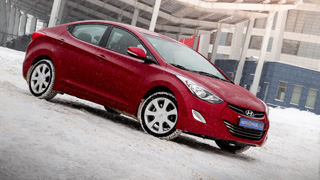 The most affordable version of the Hyundai Elantra sedan is the BASE equipment with a 132-horsepower engine of 1.6 liters and a mechanical gearbox that costs 699 thousand rubles. Not cheap, given that the equipment includes only 2 airbags, air conditioning, standard electric package, and 15-inch stamped wheels. And the Optima version is with the same engine, but with a machine gun it will pull 836 thousand rubles already! The guarantee of 3 years or 100,000 km A Hyundai Elantra leaves ambiguous sensations. A bright design, but a cheap interior, a good motor and a nimble automatic, but useless VSM settings. Elantra steamed there and the chassis well, but uncomfortable stiffness in combination with swing makes it unsuitable for our roads. It feels like the Koreans worked in a hurry here, they did not finish it. Or maybe there was no such task? Initially, the Hyundai Elantra was created for the American market, but there in a similar equipment it costs $ 22 thousand! It is not surprising that in the USA they are grabbed like hot pies. A large inexpensive car. And they wanted to spit on everything else. And we have a Hyundai Elantra for 924 thousand rubles invades the territory of Skoda Octavia and Volkswagen Jetta, having no significant advantages in front of them. And, it seems, 5017 of the realized sedans for the whole last year, the result is not so much strict quotas as a modest demand due to high prices. The Sonata’s example has already proved this. Now is the turn of Elantra? Vadim Gagarin photo of Vladislav Aliyeva Alternative Sedanov in the C+ segment in Russia is offered plenty of, but we have chosen those models that are available with motors from 140 horsepower and automatic gearboxes. Ford Focus The most popular sedan in Russia (after Russian Lada, of course) is Ford Focus last year, dealers sold almost 40 thousand cars! The love of Russians for this model is easily explained thanks to the assembly in Russia Ford offers very interesting prices for Focus, the simplest sedan now costs only 552,000 rubles. However, under the hood there will be a motor with a capacity of only 85 hp. Therefore, we are counting from a completely different focus with an engine with a capacity of 150 hp. And PowerShift. Such a car costs at least 753,000 rubles in the Trend configuration, but now a solid discount of 50 thousand rubles is valid for this version. Chevrolet Cruze is also in good demand by Chevrolet Cruze, which also attracts the buyer at the expense of interesting prices from 609,000 rubles. For a version with a 109 hp engine But an engine with a volume of 1.8 liters and a capacity of 141 hp. Plus, the automatic increase the cost of Cruze to 746,000 rubles. Skoda Octavia Skoda Octavia is not formally a sedan, but it can also be attributed to this group. True, Skoda cheaply cannot be called a version with a 1.8 -liter turbo engine with a capacity of 152 hp. And an automatic machine (yes, now it is precisely the six-band hydromechanical automatic machine to the seven-speed DSG robot that is put on it) costs at least 804 thousand rubles. The Honda Civic has a new generation of the Japanese sedan in Russia last year and is offered with one engine of 1.8 liters (142 hp) prices for versions with an automaton begin with 839,000 rubles. Renault Fluence, the French sedan from Turkey recently survived an update, during which he got a muzzle in the new branded style of Renault. Fluence with a 2.0-liter unit (138 hp) and a variator costs from 801,600 rubles.
The most affordable version of the Hyundai Elantra sedan is the BASE equipment with a 132-horsepower engine of 1.6 liters and a mechanical gearbox that costs 699 thousand rubles. Not cheap, given that the equipment includes only 2 airbags, air conditioning, standard electric package, and 15-inch stamped wheels. And the Optima version is with the same engine, but with a machine gun it will pull 836 thousand rubles already! The guarantee of 3 years or 100,000 km A Hyundai Elantra leaves ambiguous sensations. A bright design, but a cheap interior, a good motor and a nimble automatic, but useless VSM settings. Elantra steamed there and the chassis well, but uncomfortable stiffness in combination with swing makes it unsuitable for our roads. It feels like the Koreans worked in a hurry here, they did not finish it. Or maybe there was no such task? Initially, the Hyundai Elantra was created for the American market, but there in a similar equipment it costs $ 22 thousand! It is not surprising that in the USA they are grabbed like hot pies. A large inexpensive car. And they wanted to spit on everything else. And we have a Hyundai Elantra for 924 thousand rubles invades the territory of Skoda Octavia and Volkswagen Jetta, having no significant advantages in front of them. And, it seems, 5017 of the realized sedans for the whole last year, the result is not so much strict quotas as a modest demand due to high prices. The Sonata’s example has already proved this. Now is the turn of Elantra? Vadim Gagarin photo of Vladislav Aliyeva Alternative Sedanov in the C+ segment in Russia is offered plenty of, but we have chosen those models that are available with motors from 140 horsepower and automatic gearboxes. Ford Focus The most popular sedan in Russia (after Russian Lada, of course) is Ford Focus last year, dealers sold almost 40 thousand cars! The love of Russians for this model is easily explained thanks to the assembly in Russia Ford offers very interesting prices for Focus, the simplest sedan now costs only 552,000 rubles. However, under the hood there will be a motor with a capacity of only 85 hp. Therefore, we are counting from a completely different focus with an engine with a capacity of 150 hp. And PowerShift. Such a car costs at least 753,000 rubles in the Trend configuration, but now a solid discount of 50 thousand rubles is valid for this version. Chevrolet Cruze is also in good demand by Chevrolet Cruze, which also attracts the buyer at the expense of interesting prices from 609,000 rubles. For a version with a 109 hp engine But an engine with a volume of 1.8 liters and a capacity of 141 hp. Plus, the automatic increase the cost of Cruze to 746,000 rubles. Skoda Octavia Skoda Octavia is not formally a sedan, but it can also be attributed to this group. True, Skoda cheaply cannot be called a version with a 1.8 -liter turbo engine with a capacity of 152 hp. And an automatic machine (yes, now it is precisely the six-band hydromechanical automatic machine to the seven-speed DSG robot that is put on it) costs at least 804 thousand rubles. The Honda Civic has a new generation of the Japanese sedan in Russia last year and is offered with one engine of 1.8 liters (142 hp) prices for versions with an automaton begin with 839,000 rubles. Renault Fluence, the French sedan from Turkey recently survived an update, during which he got a muzzle in the new branded style of Renault. Fluence with a 2.0-liter unit (138 hp) and a variator costs from 801,600 rubles. Source: Auto.mail.ru

